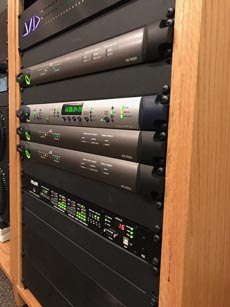Thomas Road Baptist Church Installs the First Optocore Autorouter in North America |  |  | |
Optocore has been providing professional digital transport systems for high channel counts of audio, video, and data for more the 25 years. The Digico SD series of consoles have been using the Optocore fiber network as their digital fiber transport system since their release because of the redundant and reliable performance of the network. The Optocore platform is easily programmed and connected using redundant fiber connections and allows for near instantaneous transmission of audio, control, and data without any loss or electrical interference. This makes Optocore-enabled consoles an appealing choice for audio technicians that need to transport a large amount of audio, maintain great quality audio, and not worry about IT integration or IP addresses. An additional benefit to using the Optocore fiber network with SD consoles is the ability of using any Optocore R-Series device on the same network with full control of routing, gain, and phantom power from the console surface. Thomas Road Baptist Church took advantage of this feature when they recently upgraded the worship facility to include an Optocore DD4MR-FX network MADI device and the first Optocore Route66 Autorouter installed in North America. The Route66 router is a customizable unit that allows for any combination of fiber signals -- whether audio, video, or data to be transported to and from multiple points. When configured for an Optocore network the unit automatically detects the presence of data on its fiber ports and creates redundant routing between all active locations. As locations are disconnected the Autorouter closes those ports and reestablishes a redundant network with the remaining data streams. Any Optocore unit or Digico SD series piece of equipment and be connected to the Autorouter for instant integration into the fiber network. The Autorouter can be populated to accommodate up to 20 potential locations for patch points where equipment can be connected. Route66's have been used on numerous live events and in the production/touring markets on shows that required a high degree of redundancy and flexibility; Thomas Road's services are no different. There are multiple connection points throughout the space where consoles and equipment are constantly moved around depending on the service they are hosting on any given day, demanding a robust device that is easy to operate. Possible connection points include two front-of-house positions, monitors, the equipment room and a broadcast location with a DD4MR-FX. Any console, rack or piece of Optocore equipment could potentially be connected at any location without any reprogramming required to the network. As the various patch points come online the Route66 senses the newly attached units and connects them to the other locations so the system never loses redundancy. This happens automatically, no cueing of presets is required and no technician is required to manual re-patch any physical connections thus eliminating user error and the possibility of fiber connectors getting damaged or dirty. Using the Autorouter ensures that every channel in the network is always available at every location. The same operators of Thomas Road Church have another production facility in the nearby Liberty University which utilizes a passive fiber patch bay. As they were planning for the upgrade Audio Systems Architect, Mike Gerringer wanted to implement a system that was easier to use and more technical to match the renovations that were happening to the rest of the audio system. "With the passive system there's a lot of thought that has to go into re-patching the system. Remembering which locations we're using and what connections those are," says Gerringer. "The reason for choosing the Autorouter was to simplify the day to day operation of the venue. We had looked into using a loopback system to connect every location at the same time but with the Autorouter we don't have to disconnect cables if we aren't using that location. If we aren't using monitors then we can just leave that console off. It also means that our part-time volunteers don't need to worry that the consoles are plugged in correctly or how to use a patch bay." A large component of the Church's service is its broadcasts. They've been recording their services since its founding in 1956, when they would air on a local and national TV channels. Now an Optocore DD4MR-FX is used to feed MADI to an AVID S6L and Protools recording equipment straight from the SD Racks and a Dante network. The DD4MR can support 128 MADI I/O at 48kHz sample rate networks which gives them lots of I/O for their needs. "The flexibility and the easy of use of the system is amazing," Gerringer comments. "The sound quality and warmth that we get now because of fiber is leaps and bounds above what we had before when we were using an analog distribution system. We have lots of plans moving forward on how to expand to accommodate guest musician and how to interface with our other campuses and the new optical network means we aren't limited by what channel counts or cabling." 
|

